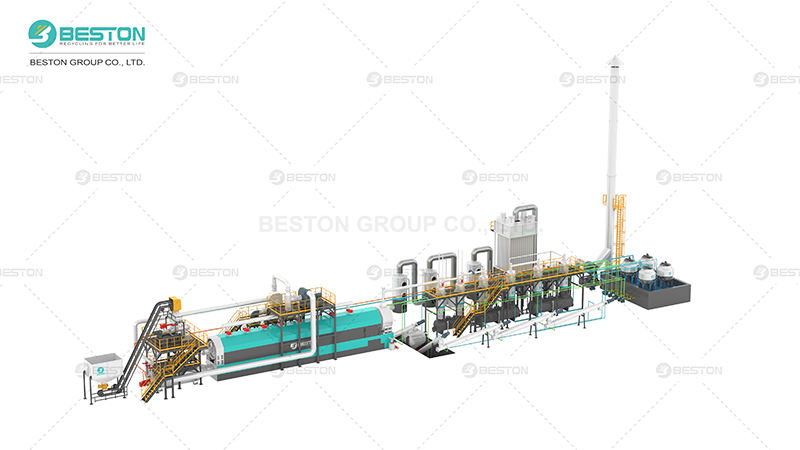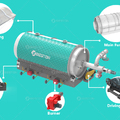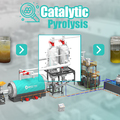In the realm of waste management and resource recovery, continuous operation represents a pivotal advancement in pyrolysis technology. Unlike batch systems, a continuous pyrolysis plant offers ongoing processing, optimizing efficiency and output. This shift towards continuous operation is setting new standards for sustainability and operational excellence in pyrolysis equipment.
Advantages of Continuous Operation
Enhanced Efficiency
A continuous pyrolysis plant operates without interruptions, allowing for uninterrupted feedstock processing. This leads to increased throughput and more consistent production rates. Continuous systems eliminate the downtime associated with batch processing, where equipment must be stopped, cleaned, and restarted. The result is a more efficient use of resources and improved overall productivity.
Cost-Effective Processing
Operational costs in a continuous pyrolysis plant are often lower than those in batch systems. Continuous processing reduces the need for manual intervention and minimizes labor costs. Additionally, the constant operation means that energy consumption can be optimized and spread more evenly over time, reducing peaks in energy demand that are often seen in batch processes. This consistent energy usage can lead to significant cost savings.
Improved Product Quality
Continuous operation allows for more precise control over processing conditions, such as temperature and feed rate. This precision helps maintain the quality of the end products. In pyrolysis, maintaining optimal conditions is crucial for producing high-quality outputs, whether it's biochar, oil, or gas. Continuous systems facilitate better control, leading to more consistent and desirable product characteristics.
Technological Advancements
Automated Control Systems
Modern continuous pyrolysis plants are equipped with advanced automated control systems. These systems monitor and adjust process parameters in real-time, ensuring optimal conditions are maintained throughout the operation. Automation reduces the risk of human error and allows for fine-tuning of the pyrolysis process, enhancing efficiency and output quality.
Integration with Other Technologies
Continuous pyrolysis plants often integrate with other technologies to enhance performance. For instance, advanced heat recovery systems can be coupled with continuous pyrolysis to capture and reuse energy generated during the process. This integration not only improves energy efficiency but also reduces the environmental impact by lowering emissions.
Scalability
The scalability of continuous pyrolysis equipment makes it suitable for a wide range of applications. Whether for industrial-scale waste management or smaller-scale operations, continuous systems can be scaled up or down to meet specific needs. This flexibility is a significant advantage, allowing businesses to adapt to varying quantities of feedstock and market demands.

Environmental Benefits
Reduced Emissions
Continuous pyrolysis plants typically operate more efficiently, leading to reduced emissions. By maintaining a steady process, these systems ensure more complete and controlled combustion of feedstock, minimizing the release of harmful pollutants. Advanced filtration and emission control systems further contribute to reducing the environmental footprint of pyrolysis operations.
Resource Efficiency
The efficiency of continuous pyrolysis plant translates into better resource utilization. By processing feedstock continuously, these systems maximize the recovery of valuable materials, such as biochar and pyrolysis oil. This efficient use of resources supports circular economy principles, where waste materials are converted into reusable products, thereby contributing to sustainability.
Implementation Considerations
Investment and Cost
The initial investment in a continuous pyrolysis plant can be higher compared to batch systems due to the advanced technology and automation involved. However, the long-term benefits, including lower operational costs and increased efficiency, often outweigh the initial expenditure. Businesses must carefully evaluate the return on investment and consider the potential cost savings over time.
Technical Expertise
Operating a continuous pyrolysis plant requires specialized knowledge and technical expertise. The advanced control systems and automation involved necessitate skilled personnel for operation and maintenance. Investing in training and technical support is crucial for ensuring smooth operation and maximizing the benefits of continuous processing.
Feedstock Management
Effective feedstock management is essential for the optimal performance of a continuous pyrolysis plant. Consistent feedstock quality and supply are crucial for maintaining steady operation and achieving desired product outputs. Businesses must establish reliable feedstock sources and implement efficient handling and preprocessing procedures.
Conclusion
The shift towards continuous operation in pyrolysis equipment represents a significant advancement in waste management technology. By enhancing efficiency, reducing costs, and improving product quality, continuous pyrolysis plants set new benchmarks for operational excellence. Embracing this technology not only supports sustainable practices but also positions businesses at the forefront of innovation in the field of pyrolysis. As the demand for efficient and environmentally friendly processing solutions grows, continuous operation will undoubtedly play a central role in shaping the future of pyrolysis equipment.





